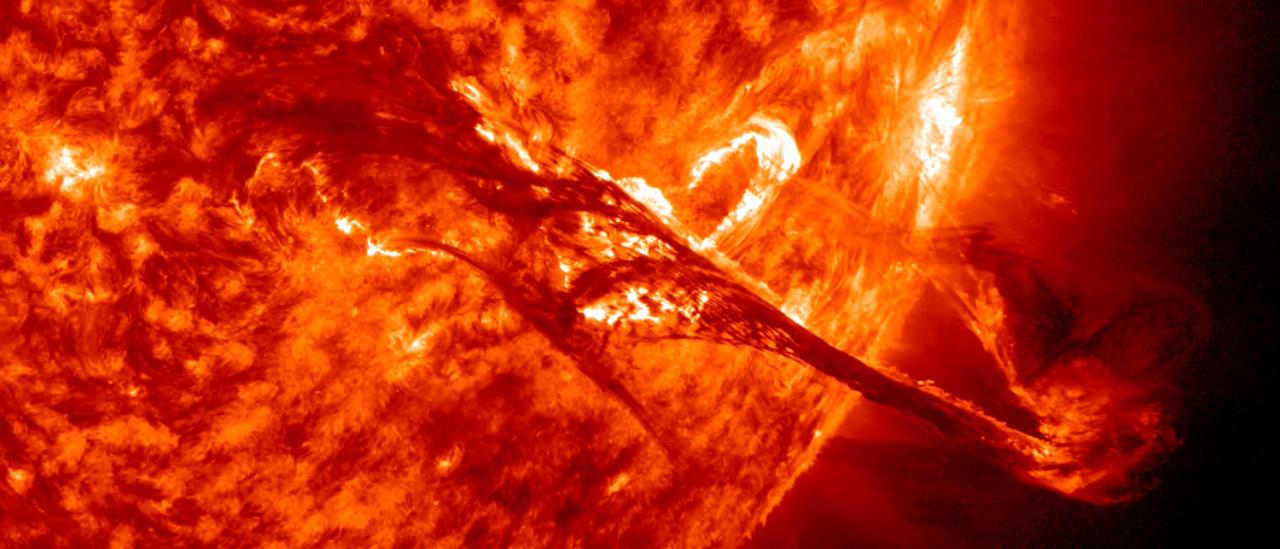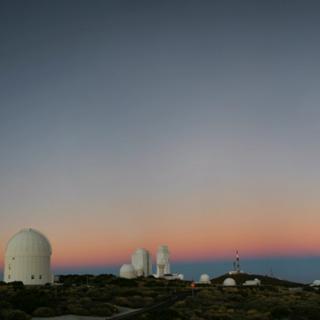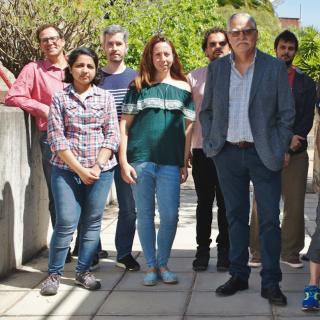Subvenciones relacionadas:
General
Los campos magnéticos son uno de los ingredientes fundamentales en la formación de estrellas y su evolución. En el nacimiento de una estrella, los campos magnéticos llegan a frenar su rotación durante el colapso de la nube molecular, y en el fin de la vida de una estrella, el magnetismo puede ser clave en la forma en la que se pierden las capas externas de forma dramática. En la vida adulta, el magnetismo da lugar a la actividad de las estrellas. Nuestro Sol tiene campos magnéticos que dan lugar a una actividad tan espectacular que es capaz de tener un impacto en la Tierra. Pero en otras estrellas, la actividad magnética es, en algunos casos, órdenes de magnitud más intensa que la solar, influenciando drásticamente el transporte de especies químicas y de momento angular, así como afectando posibles sistemas planetarios alrededor de éstas.
La finalidad de este Proyecto es estudiar diversas manifestaciones del campo magnético que se pueden observar en la atmosfera solar y en otras estrellas. Estas incluyen estructuras tan diversas como las manchas solares, los campos débiles presentes en el sol en calma o estructuras cromosféricas y coronales como los filamentos y las protuberancias. Así, se han ido abordando gradualmente los siguientes temas de investigación:
Magnetismo solar
- Estructura y evolución del campo magnético en manchas solares.
- Estructura y evolución del campo magnético en el Sol en calma.
- Estructura y evolución del campo magnético en la cromosfera y en estructuras cromosféricas (protuberancias, espículas,...)
- Estructura y evolución del campo magnético en bucles coronales.
- Estructura y evolución del campo magnético global del Sol. Estudios del ciclo de actividad magnética.
- Estudio empírico de la propagación de ondas magnetohidrodinámicas en el seno de estructuras magnéticas.
- Estudio empírico de mecanismos relacionados con el calentamiento de las capas externas del Sol.
- Estudio empírico de la influencia de la ionización parcial en la dinamica de la atmosfera solar.
- Implicación en el proyecto del Telescopio Solar Europeo.
Magnetismo estelar
- Desarrollo de métodos numéricos para el diagnóstico del campo magnético estelar, tanto en la superficie como en la cromosfera.
- Estudio del magnetismo en protuberancias estelares.
- Impacto del campo magnético en las últimas fases de la evolución estelar.
Miembros
Resultados
- Ondas espirales en manchas solares: Se han interpretado como ondas magnetoacústicas que se propagan desde el interior hasta capas atmosféricas siguiendo la dirección del campo magnético. Se ha caracterizado la topología del campo magnético de la mancha, descartando que la forma espiral sea consecuencia del retorcimiento de las líneas de campo (Felipe et al. 2019).
- Respuesta magnética a umbral flashes: Observaciones espectropolarimétricas simultáneas de las líneas cromosféricas He I 10830 y Ca II 8542 fueron usadas para estimar las fluctuaciones del campo magnético asociado a ondas de choque. Los choques provocan la expansión de las líneas de campo (Houston et al. 2018, incluye a A. Asensio Ramos).
Actividad científica
Publicaciones relacionadas
-
An Iterative OLA Method for Inversion of Solar Spectropolarimetric Data. I. Single- and Multiple-variable Inversions of Thermodynamic Quantities
This paper describes an adaptation of the Optimally Localized Averaging (OLA) inversion technique, originally developed for geo- and helioseismological applications, to the interpretation of solar spectroscopic data. It focuses on inverting the thermodynamical properties of the solar atmosphere, assuming that the atmosphere and radiation field are
Agrawal, Piyush et al.Fecha de publicación:
22023 -
Exploring Magnetic Loops and Serpentine Fields in the Quiet Sun with the GRIS-IFU
Synthetic observations produced from radiative magnetohydrodynamic simulations have predicted that higher polarization fractions in the quiet solar photosphere would be revealed by increasing the total integration time of observations at GREGOR resolutions. We present recently acquired disk center observations of the Fe I 15648.5 Å line obtained
Collados, Manuel et al.Fecha de publicación:
22023 -
The role of cooling induced by mixing in the mass and energy cycles of the solar atmosphere
In many astrophysical systems, mixing between cool and hot temperature gas/plasma through Kelvin-Helmholtz-instability-driven turbulence leads to the formation of an intermediate temperature phase with increased radiative losses that drive efficient cooling. The solar atmosphere is a potential site for this process to occur with interaction between
Hillier, Andrew et al.Fecha de publicación:
42023 -
Impact of opacity effects on chromospheric oscillations inferred from NLTE inversions
Context. Spectropolarimetric inversions are a fundamental tool for diagnosing the solar atmosphere. Chromospheric inferences rely on the interpretation of spectral lines that are formed under nonlocal thermodynamic equilibrium (NLTE) conditions. In the presence of oscillations, changes in the opacity impact the response height of the spectral lines
Felipe, T. et al.Fecha de publicación:
22023 -
Solar-cycle and Latitude Variations in the Internetwork Magnetism
The importance of the quiet-Sun magnetism is that it is always there to a greater or lesser extent, being a constant provider of energy, independently of the solar cycle phase. The open questions about the quiet-Sun magnetism include those related to its origin. Most people claim that the local dynamo action is the mechanism that causes it. This
Trelles Arjona, J. C. et al.Fecha de publicación:
22023 -
Magnetic field amplification and structure formation by the Rayleigh-Taylor instability
We report our results from a set of high-resolution, two-fluid, non-linear simulations of the magnetized Rayleigh Taylor instability (RTI) at the interface between a solar prominence and the corona. These data follow results reported earlier on linear and early non-linear RTI dynamics in this environment. This paper is focused on the generation and
Popescu Braileanu, B. et al.Fecha de publicación:
22023 -
Vortex Motions in the Solar Atmosphere
Vortex flows, related to solar convective turbulent dynamics at granular scales and their interplay with magnetic fields within intergranular lanes, occur abundantly on the solar surface and in the atmosphere above. Their presence is revealed in high-resolution and high-cadence solar observations from the ground and from space and with state-of-the
Tziotziou, K. et al.Fecha de publicación:
22023 -
Towards the Identification and Classification of Solar Granulation Structures Using Semantic Segmentation
Solar granulation is the visible signature of convective cells at the solar surface. The granulation cellular pattern observed in the continuum intensity images is characterised by diverse structures e.g., bright individual granules of hot rising gas or dark intergranular lanes. Recently, the access to new instrumentation capabilities has given us
Díaz Castillo, S. M. et al.Fecha de publicación:
62022 -
Optical design of an image-slicer integral field unit with two output slits
The optical design of an integral field unit (IFU) based on image-slicers represents an interesting design exercise because of the small size of the components and the critical parameters to reduce optical aberrations. When the IFU to be designed is also intended to substitute an IFU prototype that is already integrated into a spectropolarimeter
Vaz Cedillo, Jacinto J. et al.Fecha de publicación:
12022 -
Polarimetric characterization of segmented mirrors
We study the impact of the loss of axial symmetry around the optical axis on the polarimetric properties of a telescope with segmented primary mirror when each segment is present in a different aging stage. The different oxidation stage of each segment as they are substituted in time leads to non-negligible crosstalk terms. This effect is
Collados, M. et al.Fecha de publicación:
62022 -
Large Ion-neutral Drift Velocities and Plasma Heating in Partially Ionized Coronal Rain Blobs
In this paper we present a numerical study of the dynamics of partially ionized coronal rain blobs. We use a two-fluid model to perform a high-resolution 2D simulation that takes into account the collisional interaction between the charged and neutral particles contained in the plasma. We follow the evolution of a cold plasma condensation as it
Martínez-Gómez, David et al.Fecha de publicación:
122022 -
FarNet-II: An improved solar far-side active region detection method
Context. Activity on the far side of the Sun is routinely studied through the analysis of the seismic oscillations detected on the near side using helioseismic techniques such as phase-shift sensitive holography. Detections made through those methods are limited to strong active regions due to the need for a high signal-to-noise ratio. Recently
Broock, E. G. et al.Fecha de publicación:
112022 -
Observational and numerical characterization of a recurrent arc-shaped front propagating along a coronal fan
Context. Recurrent, arc-shaped intensity disturbances were detected by extreme-ultraviolet channels in an active region. The fronts were observed to propagate along a coronal loop bundle rooted in a small area within a sunspot umbra. Previous works have linked these intensity disturbances to slow magnetoacoustic waves that propagate from the lower
Sieyra, M. V. et al.Fecha de publicación:
112022 -
Ambipolar Diffusion in the Lower Solar Atmosphere: Magnetohydrodynamic Simulations of a Sunspot
Magnetohydrodynamic (MHD) simulations of the solar atmosphere are often performed under the assumption that the plasma is fully ionized. However, in the lower solar atmosphere a reduced temperature often results in only the partial ionization of the plasma. The interaction between the decoupled neutral and ionized components of such a partially
MacBride, Conor D. et al.Fecha de publicación:
102022 -
Polarization Accuracy Verification of the Chromospheric LAyer SpectroPolarimeter
We have developed an advanced UV spectropolarimeter called Chromospheric LAyer SpectroPolarimeter (CLASP2), aimed at achieving very high accuracy measurements (<0.1% at 3 σ ) of the linear (Q /I and U /I ) and circular (V /I ) polarizations of the Mg II h and k lines (280 nm). CLASP2 was launched on board a NASA sounding rocket on April 11, 2019
Song, Donguk et al.Fecha de publicación:
102022 -
Evidence of a flare ignited above a low-latitude spotted active region in the ultrafast rotator HK Aqr
We study the magnetic activity in the ultrafast rotator dMe HK Aqr using tomography techniques with high-resolution spectroscopy. We aim to characterize how this magnetic activity appears in a regime of very fast rotation without external forces, given that HK Aqr is, very likely, a single star. We find dark spots located at low latitudes. We also
Martínez González, María Jesús et al.Fecha de publicación:
112022 -
The European Solar Telescope
The European Solar Telescope (EST) is a project aimed at studying the magnetic connectivity of the solar atmosphere, from the deep photosphere to the upper chromosphere. Its design combines the knowledge and expertise gathered by the European solar physics community during the construction and operation of state-of-the-art solar telescopes
Quintero Noda, C. et al.Fecha de publicación:
102022 -
Quiet Sun Center to Limb Variation of the Linear Polarization Observed by CLASP2 Across the Mg II h and k Lines
The CLASP2 (Chromospheric LAyer Spectro-Polarimeter 2) sounding rocket mission was launched on 2019 April 11. CLASP2 measured the four Stokes parameters of the Mg II h and k spectral region around 2800 Å along a 200″ slit at three locations on the solar disk, achieving the first spatially and spectrally resolved observations of the solar
Rachmeler, L. A. et al.Fecha de publicación:
92022 -
First Light of the Integral Field Unit of GRIS on the GREGOR Solar Telescope
An Integral Field Unit (IFU) based on image slicers has been added to the GREGOR Infrared Spectrograph (GRIS). This upgrade to the instrument makes possible 2D spectropolarimetry in the near-infrared by simultaneously recording the full Stokes profiles of spectral lines (in a given spectral interval) at all the points in the field of view (FOV). It
Dominguez-Tagle, C. et al.Fecha de publicación:
72022 -
Doppler-velocity Drifts Detected in a Solar Prominence
We analyzed multiline observations of a quiescent prominence from the slit spectrograph located at the Ondřejov Observatory. Dopplergrams and integrated intensity maps of the whole prominence were obtained from observations in six spectral lines: Ca II H, Hϵ, Hβ, He I D3, Hα, and Ca II IR. By combining integrated intensity maps with non-LTE
Zapiór, Maciej et al.Fecha de publicación:
72022

![Izquierda - Imagen RGB de la nebulosa de Orión y M43 obtenida filtros estrechos con la cámara WFC en el INT: H alfa (rojo), [S II] 6716+30 (verde), [O III] 5007 (azul). Derecha - Imagen en falso color de la nebulosa planetaria NGC 6778. En azul se ve la emisión en la línea de O II tomada con el filtro sintonizable azul del instrumento OSIRIS en el GTC; en verde imagen con el filtro estrecho de [O III] del Nordic Optical Telescope (NOT). Izquierda - Imagen RGB de la nebulosa de Orión y M43 obtenida filtros estrechos con la cámara WFC en el INT: H alfa (rojo), [S II] 6716+30 (verde), [O III] 5007 (azul). Derecha - Imagen en falso color de la nebulosa planetaria NGC 6778. En azul se ve la emisión en la línea de O II tomada con el filtro sintonizable azul del instrumento OSIRIS en el GTC; en verde imagen con el filtro estrecho de [O III] del Nordic Optical Telescope (NOT).](/sites/default/files/styles/crop_square_2_2_to_320px/public/images/project/imagen_web.jpg?itok=fsBmV9CO)

